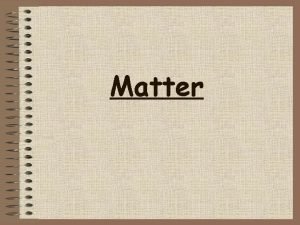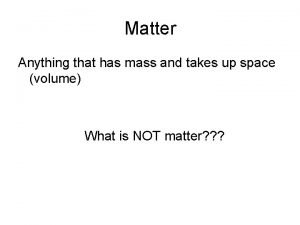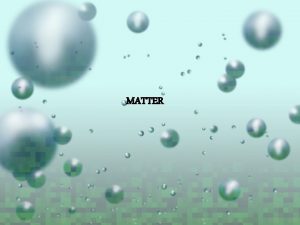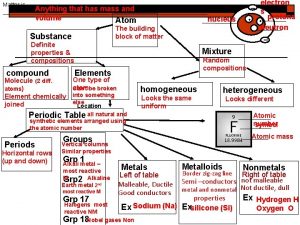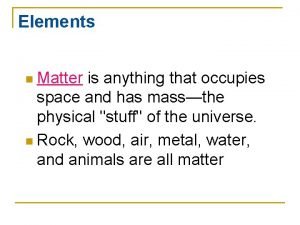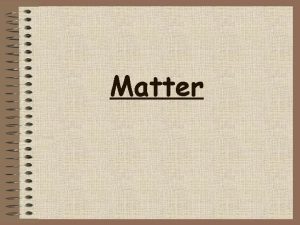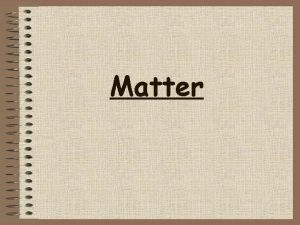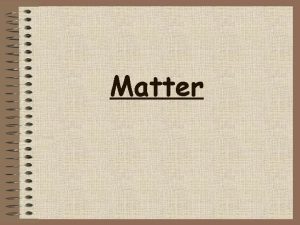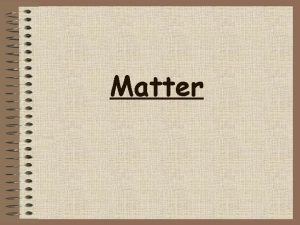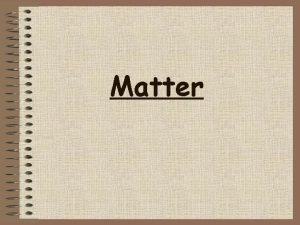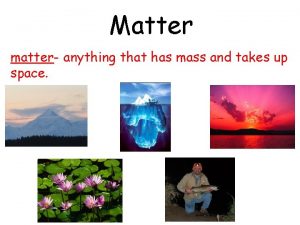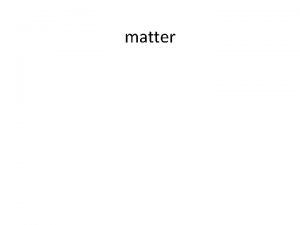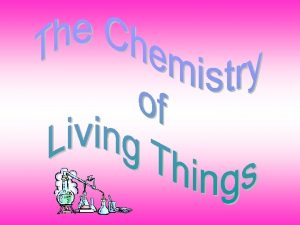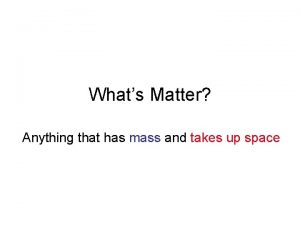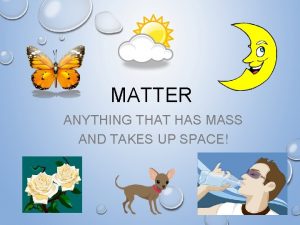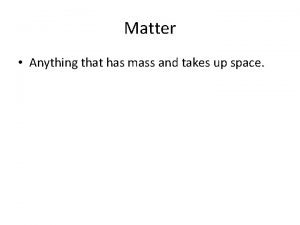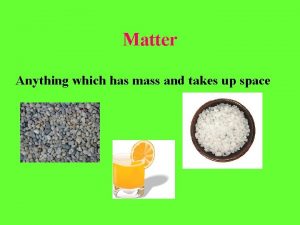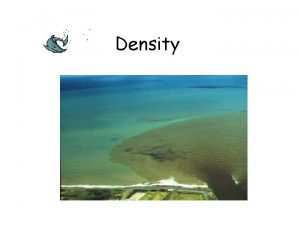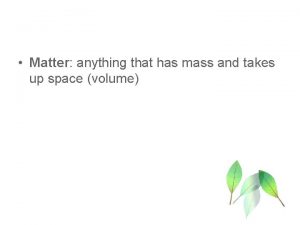Matter Matter Anything that has mass and takes
























- Slides: 24

Matter

Matter • Anything that has mass and takes up space • States of Matter • Solid • Liquid • Gas • State of matter determined by: • Particle motion • Particle forces

• Matter that has a definite shape and a definite volume • Strong attractive forces • Slow motion • Vibrate back and forth • Particles are close together Solid • Two Types of Solids • Crystalline • Particles arranged in a specific repeating order • Amorphous • Particles arranged randomly

Liquid • Matter with a definite volume but no definite shape • Weaker attractive force • Faster moving particles • Particles spread apart • Flows and takes the shape of containers

Liquid--Viscosity • Measurement of a liquids resistance to flow • High viscosity=slow flow • Low viscosity=fast flow • Depends on: • Particles mass • Particle shape • Attraction between particles • Decreases as liquid becomes warmer

Liquid—Surface Tension • Uneven forces acting on the particles on the surface of a liquid • Cohesion • Attraction between similar molecules

Gas • Matter that has no definite shape and no definite volume • Weak or absent attractive forces • Fastest moving particles • Particles spread to fill their container

Vapor • Normally a solid or liquid at room temperature • Examples: • Water, rubbing alcohol, iodine, mercury, gasoline

Gas Behavior Pressure • Amount of force applied per unit • Result of constantly moving gas particles colliding with their container • Greatest volume → least pressure • Less volume → more pressure • Least volume → most pressure

Gas Behavior Boyle’s Law • Pressure of a gas increases if the volume decreases and pressure of a gas decreases if the volume increases, when temperature is constant

Gas Behavior Robert Boyle

Gas Behavior Temperature • Changing temperature of a gas affects its behavior • Low temperature=low kinetic energy=less volume • High temperature=high kinetic energy=more volume

Gas Behavior Charles’s Law • The volume of a gas increases with increasing temperature, if the pressure is constant

Gas Behavior Jacques Charles

Gas Behavior Charles’s Law • The volume of a gas increases with increasing temperature, if the pressure is constant

Kinetic Molecular Theory • Explanation of how particles in matter behave 1. Small particles make up all matter 2. Particles are in constant, random motion 3. Particles collide with other particles, other objects, and the walls of their container 4. When particles collide, no energy is lost

Physical Properties Mass Dependent Amount of matter in an object Conductivity Independent Ability of matter to conduct electricity or heat Volume Dependent Amount of space something occupies Density Dependent Amount of mass per unit of volume

Physical Properties State of Matter Independent Solid, liquid, gas Solubility Independent Ability of one substance to dissolve in another Magnetism Independent Attractive forces for metals Boiling/ Melting Point changes state Dependent Temperature at which material

Physical Changes • A change in size, shape, form or state of matter • Matter’s identity stays the same • Types • Change in shape or size • Change in state of matter • Adding thermal energy • Removing thermal energy • Dissolving

Physical Changes Examples:

State Changes Deposition

State Changes • Vaporization • Add thermal energy • Liquid to a gas • Melting • Add thermal energy • Solid to a liquid • Condensation • Remove thermal energy • Gas to a liquid • Freezing • Remove thermal energy • Liquid to a solid

State Changes • Sublimation • Deposition • Change from a solid to a gas without going through a liquid state • Change from a gas to a solid without going through a liquid state • Example: dry ice • Example: frost

Physical Changes Conservation of Mass • Mass is the same before and after change Conservation of Matter • Particles are the same before and after change
 Anything that takes up space and has mass
Anything that takes up space and has mass Mass vs matter
Mass vs matter Anything that has mass and take up space
Anything that has mass and take up space Anything that has mass and takes up space is
Anything that has mass and takes up space is Anything that takes up space and has mass
Anything that takes up space and has mass Matter is anything that
Matter is anything that What is anything that has mass and takes up space
What is anything that has mass and takes up space Is anything that has mass and volume
Is anything that has mass and volume Anything that takes up space and has mass
Anything that takes up space and has mass Mass number defintion
Mass number defintion Matter anything that takes up space
Matter anything that takes up space Matter is anything that
Matter is anything that Matter is anything that occupies
Matter is anything that occupies It is anything that has mass and occupies space
It is anything that has mass and occupies space Matter has mass and occupies space
Matter has mass and occupies space Matter is anything that occupies space and has
Matter is anything that occupies space and has Phân độ lown ngoại tâm thu
Phân độ lown ngoại tâm thu Block nhĩ thất cao độ
Block nhĩ thất cao độ Thơ thất ngôn tứ tuyệt đường luật
Thơ thất ngôn tứ tuyệt đường luật Thơ thất ngôn tứ tuyệt đường luật
Thơ thất ngôn tứ tuyệt đường luật Walmart thất bại ở nhật
Walmart thất bại ở nhật Tìm vết của đường thẳng
Tìm vết của đường thẳng Hãy nói thật ít để làm được nhiều
Hãy nói thật ít để làm được nhiều Tôn thất thuyết là ai
Tôn thất thuyết là ai Gây tê cơ vuông thắt lưng
Gây tê cơ vuông thắt lưng


